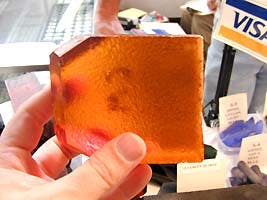How to Identify Synthetic Rough in Gemstone Parcels
Telling synthetic rough from natural stones in a gem parcel can be challenging. These tips can help you find some telltale signs of lab-created material.
1 Minute Read
In my estimation, 10% to 30% of some supposedly natural gem parcels may be synthetic.
Most experienced gem dealers can spot synthetic rough or at least suspect something is off. Unfortunately, the average consumer may find it almost impossible to identify lab-made stones mixed with natural rough in a parcel. Ultimately, whom you are dealing with is important in the gem trade. There are honest people and reputable dealers out there. There are some questionable individuals, too.
Tips for Spotting Lab-Made Rough
- A really cheap price for a gemstone parcel is a good indication it may contain synthetic rough. If the deal is too good to be true, so are the stones.
- If the gemstones in a parcel look exactly alike in both color and size, they may be synthetic. For example, natural quartz stones usually vary in color and size and may show color zoning and twinning. (However, some manufacturing processes can create these effects, too).
- A lack of crystal points can indicate synthetic stones. Most synthetic material is produced in large blocks. The makers break up or cobb them into smaller pieces to make the synthetic rough look real. However, these pieces will likely have no points because they would have to be cut. It's unlikely (but not out of the question) that anyone would spend the time and effort on this for synthetic rough destined for a parcel.
- Look for the pebble-like surface that may occur on synthetic rough, like the synthetic citrine pictured below. Once you know what it looks like it's easy to spot.
- Size is often a good indication of synthetic material. If the stone is very large and has great color, especially for the price, beware.
A Comment Regarding Makers of Synthetic Rough Gems
I've always thought that those who synthesize gemstones (especially emerald, tanzanite, diamond, ruby, and quartz) should be required by law to put a dye tag in their products. Only visible when viewed under a certain wavelength of light, the dye would be a clear indication of synthetic rough. I'm aware of only one ruby manufacturer that does this.
If all manufacturers of synthetic gems were required to dye tag their products, it would make no difference to the synthetic market. The fact is, most of these manufacturers choose not to make their product easily identifiable. Makes you wonder what their real market is, doesn't it?
Jeff R. Graham
The late Jeff Graham was a prolific faceter, creator of many original faceting designs, and the author of several highly-regarded instructional faceting books such as Gram Faceting Designs.
Related Articles
Amethyst Value, Price, and Jewelry Information
Citrine Value, Price, and Jewelry Information
Citrine Engagement Ring Guide
What is the Average Gemstone Faceting Yield?
Latest Articles
Precision Faceting a Story Gemstone: Choosing Rough
32 Green Gemstones (How Many Do You Know?)
A Guide to Antique Georgian Jewelry
Hambergite Value, Price, and Jewelry Information
Never Stop Learning
When you join the IGS community, you get trusted diamond & gemstone information when you need it.
Get Gemology Insights
Get started with the International Gem Society’s free guide to gemstone identification. Join our weekly newsletter & get a free copy of the Gem ID Checklist!
